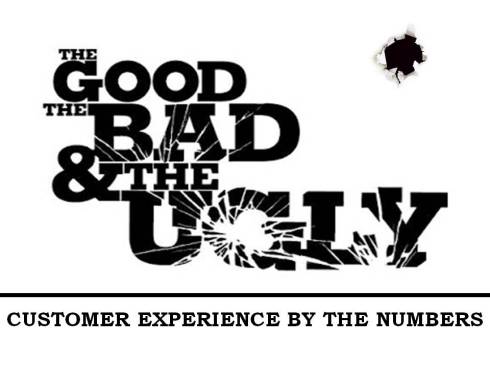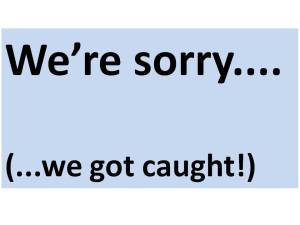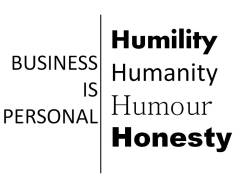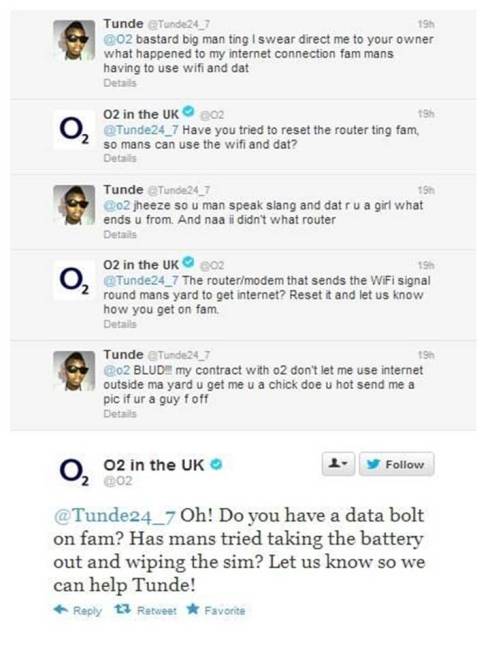Crisis of leadership
The 2013 Edelman Trust Barometer is out this week – the shorthand summary would be corporate leadership is in crisis – and, as usual, it paints a fascinating global picture of shifting, evolving and fragmenting attitudes to big business and governments and how the nature of ‘trust’ is changing.
Edelman rightly zoom in on the world of financial services, and banks in particular, where, not surprisingly, trust levels have fallen still further (halved in fact, in the UK, and even worse in Ireland), making life harder and harder for companies. Reputation is indeed a fragile construct, as Robert Pattinson’s character says.
Here, then are some reflections on the survey findings, a slideshare presentation of which can be found here.
Culture eats everything for breakfast
Not just strategy, it seems. It’s fascinating to read that when the informed public were asked what they felt were the biggest causes of recent high profile banking scandals, almost 60% felt it was down to internal factors within the company’s control, rather than external. This is about how things got done in these companies. Notably:
- Corporate cultures driven by compensation / bonuses (23%)
- Corporate corruption (25%)
- Conflicts of interests (11%)
The last one is key, and maybe even drives the others. What we’re talking about here is the realpolitick world of trade-offs where what Peter Scott-Morgan calls the unwritten rules come into play, with a vengeance. For example, serve your boss or your boss’s boss as he/she controls your reward, or forget the customer’s longer term needs, just sell now. Look, for example, to the hot-off-the-press story about the culture at Barclays Wealth, a US arm of the bank, described as one of “revenue at all costs”. Click here for the story. No wonder it’s a crisis of leadership, because yes, cultures are set by leaders and it’s all within their control.
Or, rather, not in their control : there was a fascinating study last year from Deloitte’s “Culture in the Workplace” that reported that while 94% of executives say workplace culture is important (who wouldn’t!), only 19% say their own culture is widely upheld! No wonder the unwritten rules take over.
Managing the conflicts, managing the timeframes
Managing for ‘shareholder value’ creates real conflicts. Even Jack Welch said in 2009, “On the face of it, shareholder value is the dumbest idea in the world. Shareholder value is a result, not a strategy… your main constituencies are your employees, your customers and your products”.
Roger Martin, ex- dean of the Rotman School of Management in Toronto writes about shifting focus back to delighting the customer, and says, “If you take care of customers, shareholders will be drawn along for a very nice ride. The opposite is simply not true: if you try to take care of shareholders, customers don’t benefit”.
To me, it’s also about time frames. A jam-today ‘revenue at all costs’ mindset will inevitably conflict with the customer’s longer-term interests. I’m reminded of a good piece in the Guardian in November last year, “Leaders must stay close to principles of service” by Tim Macartney where he talk about the Iroquois Confederacy of First Nation’s people in the north-east US who, when they take a decision, submit the issue to the principle of seven generations: “Will this decision when translated into action have any kind of harmful outcome on our children seven generations to come?” Tim goes on to say, by way of contrast, “we have constructed a system that doesn’t even consider such questions, instead asking something rather more limited in scope and moral probity: “How will this benefit our shareholders?” And since the leaders of large organisations are often also shareholders, “How will this benefit … me?” And that takes us right back to the unwritten rules (what do I really need to do to keep my boss happy and get paid?) which, in the absence of anything else, become our rules of thumb for navigating the conflicts.
The (Bob) Diamond of Influence
While not new news, it’s fascinating that credibility as a trusted information source has been shifting away from formal and hierarchical sources – CEOs, PR spokespeople – to experts (assumed to be independent and thus trustworthy) and the more informal sources, ‘people like me’, including the rank and file employees in organisations. The theory being, they really know what it’s like, and are more likely to it tell it like it is. Edelman tells us that “a person like yourself” is now trusted nearly twice as much as a CEO. As Edelman suggests, influence has become democratized.
So, out with the old and traditional pyramid of influence – a top-down, authority-driven model – and in with the new, the pyramid of community where social activists, passionate consumer advocates and employees are powerful – because authentic – voices.
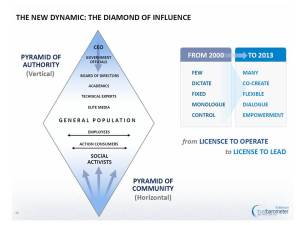
Edelman talk about the diamond of influence, see above, the new model for stakeholder interaction and management. I’m not sure it’s a diamond, a pretzel might be more appropriate, as consumers might well be going round the information and engagement loops quite a few times, and consumers and customers now have many more opportunities to amass different viewpoints, and concurrently too. I agree that “this is not a linear process but rather it is dynamic, continual and evolutionary in nature”.
It’s certainly continual – the research states that nearly 2/3rds of us say we need to hear a message 3-5 times before we believe it. And it’s a message that’s constantly being tested in the public spotlight. One slip and that’s it, back to the long hard slog of rebuilding, and we all have memories like elephants, these days. In fact, more to the point, we don’t need to have memories like elephants, we just need to know how to google.
Can trust be ‘rebuilt’?
There’s a great quote in a Wolff Olins report from last year, ‘Game Changers’ that says, “It’s easier for a trusted brand to become a bank than it is for a bank to become trusted”.
In the just published World Economic Forum Global Agenda Outlook, Michael J. Elliott, President and CEO of ONE USA challenges the notion of rebuilding an ‘old model’ and reinforces the power of informal networks to build trust:
“There has been a breakdown in trust in established institutions. But if we think that the solution is to rebuild trust in those same institutions, we may be missing the signal. Social media is creating new institutions. They may not be corporations, they may not have an HQ, but it is possible that we are finding new informal institutions that enable people to do things together. People today are less influenced by me, or you, or for that matter, by famous people, than by their friends”.
Trust as a leading indicator
An Edelman blog linked to the 2013 results says that trust is a leading indicator unlike reputation, which is the sum of perceptions of past behaviours. I like that. So, what then drives Trust? Here the report gets really interesting in giving us 16 attributes of trust, grouped into five clusters, with “engagement” the most important. See slide.
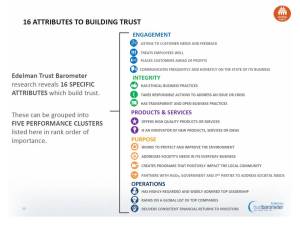
Engagement breaks down into treating customers and employees well, putting their needs first and open and honest communications .Hardly rocket science, in fact much more like good old common sense, but it’s going to take a lot more than simply writing and saying this repeatedly.
For me, it all comes back to the survey data about the perceived causes of the crises, and the C-word, Culture. It means resolving the conflicts of interest and being very clear about what ultimately drives long term and sustainable business success. In the words of Richard Branson:
“For us, our employees matter most. It just seems common sense to me that, if you start off with a happy, well-motivated workforce, you’re much more likely to have happy customers. And in due course, the resulting profits will make your shareholders happy”.
Tags: communication, leadership, Organizational culture, Public relations, trust
